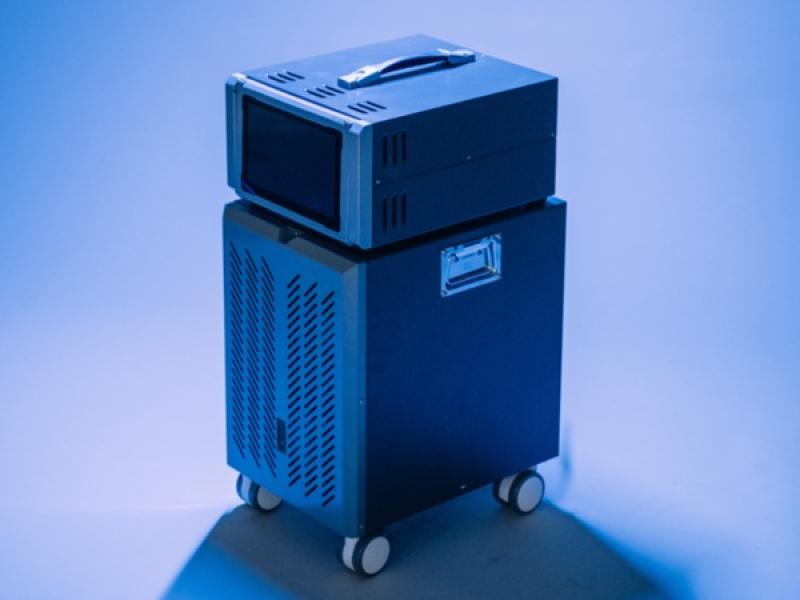
Rain Cage Carbon Inc. has developed a process to create fullerenes – hollow molecules made of interlocking carbon atoms which are used in dozens of industries – at scale.
Fullerenes are derived from carbon dioxide (CO2) emission streams, and the resulting material can be used in everything from electric vehicle batteries to carbon microchips for quantum computing.
“What we do is, we process emissions gases into something that can be useful or valuable, and not let it just go up into the air. What fullerenes are is a combination of carbons that we've been able to manipulate into a form that is incredibly stable. So a fullerene looks like a soccer ball where each one of the points is a carbon, and this is an incredibly stable form. It becomes an actual useful commodity,” Blair Aiken, Rain Cage’s chairman and co-founder, told SustainableBiz.
“The fullerenes are ideal products for solar panels, batteries, all of the different things that are actually (part of) the next transition. What can we do to take advantage of cleaning the environment while producing products that would further aid sustainability?”
Although prices for the molecules vary widely based on their usage, a company release states fullerenes can be valued at over $221 million per gram.
Calgary-based Rain Cage was founded in 2020 to help decarbonize industries. It has also produced a proprietary CO2 capture system, EDEN.
Rain Cage’s fullerenes process
Rain Cage was created in part to bring together experts including Mark Fertman, experienced in electrochemical and cathodic sciences; Debbie Maguire, a leader in advanced coating technologies; and Gerard Campeau, with expertise in thermoelectric technologies. While the company is still young, Aiken explained it has taken about 25 years to reach this point, given the work these and other experts have undertaken over the years.
He also said the company’s method can process any stream, from a two per cent CO2 concentration to 60 to 70 per cent, for approximately two kilowatts of energy. It is able to do so by the tonne.
Like the EDEN system, the use of scale is variable, and can be applied to anything from a car engine to an oil and gas plant.
“It's gaseous electrochemical. Instead of putting lots and lots of pressure and lots and lots of heat together, we manipulate voltage to create an environment. It's not plasma, but in an environment that allows us to manipulate the carbon emission stream,” Aiken said.
“It's new, it's something that people hadn't really considered before. Usually, most processes, you throw a lot (of) heat and lots of pressure. We do the opposite.”
Rain Cage can utilize existing fabrication facilities for oil and gas to produce its fullerenes machines, but as the company grows there are plans to build its own facilities.
The cost of the machines will vary based on the needs of the client and what is involved in integrating into their systems, although Aiken said they are “affordable.”
Rain Cage’s future plans
Aiken did not offer specifics on customers interested in the fullerenes, saying only that interest was immediate and global. However, the present focus for Rain Cage is EV batteries which contain graphite – a carbon-based material.
“The graphite comes from the other side of the world," he said. "We can take the emissions, and we can convert it into something that you can use instead of graphite in the battery, so you don't have to ship it across the world and it's readily available.
“And it's better than what you would use as the traditional alternative.”
The firm is also working on the next generation of semiconductors, he said, which will be carbon-based.
The company says it is developing several new proprietary technologies based on this discovery which will be announced in late 2023, in addition to upcoming decarbonization deployment projects to be launched in Q3 of this year.
“Oil and gas, power plants, industrial manufacturing facilities, compressor stations, coal plants,” Aiken said, “anything that's emitting that needs to get into a decarbonization path is very important.”
Aiken discussed working on decarbonization projects in towns largely based around a sole, carbon-emitting industry.
The firm currently has about 30 employees, so taking on these projects will involve adding more personnel.
There is also a focus on improving the fullerenes process in the future, whether via Rain Cage’s own hand or by another group of scientists and engineers.
“What we have is a foundational technology. It's the start of thinking about carbon as a refinable material . . . From our standpoint, our products can affect at least 70 per cent of all the products that are made on the planet today, and make them more sustainable at the same time,” he said. “That will involve lots of people smarter than me . . . working together with us to advance our products.”










